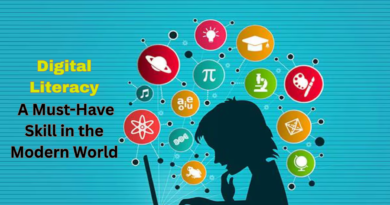ONLINE EDUCATION OPPORTUNITIES AND CHALLENGES
Education is the backbone of society. Over the last few years, technology has changed the way we learn and share knowledge. One of the biggest revolutions in the education sector is online education. From school students to working professionals, millions of people are now learning online through smartphones, laptops, and tablets. While online education has opened many new opportunities, it also brings some challenges that must be solved for better results.
Opportunities in Online Education
1. Easy Access to Education
One of the greatest advantages of online education is accessibility. Students from remote villages or small towns can now attend classes from the best teachers without moving to big cities. A student living in a rural area can join a virtual class conducted by experts in another country. This breaks the barrier of distance and makes quality education available to everyone.
2. Flexible Learning
Unlike traditional classrooms, online education gives flexibility. Students can learn at their own pace and schedule. Working professionals who cannot attend physical classes can still continue their education after office hours. Housewives, retired people, and differently-abled individuals also benefit from the comfort of learning from home.
3. Variety of Courses
Online platforms offer a wide range of courses. From science and mathematics to photography, coding, business management, and even cooking everything is available online. This variety allows learners to explore different subjects and improve their skills as per their interests.
4. Affordable Education
Online courses are usually cheaper than traditional education. Many platforms also offer free courses or scholarships. Students save money on travel, hostel, and books. Digital study material like e-books and recorded lectures reduces the overall cost of learning.
5. Use of Technology and Innovation
Online education uses interactive tools like videos, animations, virtual labs, and quizzes. These methods make learning more interesting and effective. Artificial Intelligence and Virtual Reality are now being used to give students a real-life classroom experience.
6. Global Learning Community
Online education connects students and teachers from different parts of the world. This creates a global learning community, where people can exchange ideas, share cultural experiences, and develop international networks.
Challenges in Online Education
1. Lack of Internet and Devices
The biggest challenge is the digital divide. Not every student has a good internet connection or a personal laptop or smartphone. Many students in rural and poor families struggle to attend online classes because of weak connectivity or lack of digital devices.
2. Less Face-to-Face Interaction
In traditional classrooms, students interact with teachers and classmates directly. This helps in personality development, teamwork, and communication skills. In online education, personal interaction is limited, which may affect social learning and emotional bonding.
3. Distractions and Lack of Discipline
Studying from home often brings distractions like social media, TV, or family responsibilities. Without strict schedules, some students lose focus and delay their studies. Self-discipline becomes very important in online learning, but not everyone can maintain it.
4. Quality of Content and Teaching
Not all online courses maintain the same level of quality. Some platforms may provide outdated material or untrained teachers. Without proper regulation, students may end up wasting time and money on low-quality courses.
5. Health Issues
Spending long hours in front of screens causes health problems like eye strain, headaches, and back pain. Limited physical activity also affects the fitness of students. Mental stress due to isolation and lack of peer interaction is another growing issue.
6. Limited Practical Training
Subjects like engineering, medical science, or laboratory work require hands-on practice. Online education cannot fully replace real-life experiments and practical training. This becomes a major challenge for professional courses.
The Way Forward
To make online education more successful, governments, schools, and technology companies must work together. Affordable internet should be made available in rural areas. Schools should provide digital devices to students who cannot afford them. Teachers should be trained to handle online platforms effectively. A balance between online and offline education, called blended learning, can give the best results.
Parents and teachers must also guide students on how to stay disciplined while studying online. Regular breaks, physical exercise, and safe screen time should be encouraged. Quality checks should be introduced so that only authentic courses and trained instructors are allowed to teach online.
Conclusion
Online education has opened a new world of opportunities. It has made learning easier, more flexible, and more affordable. At the same time, it faces challenges like lack of infrastructure, discipline, and practical exposure. If these challenges are addressed, online education can become a powerful tool to shape the future of learning. Instead of replacing traditional classrooms completely, online education should complement them. With the right balance, the combination of technology and traditional teaching can make education accessible and effective for everyone.




